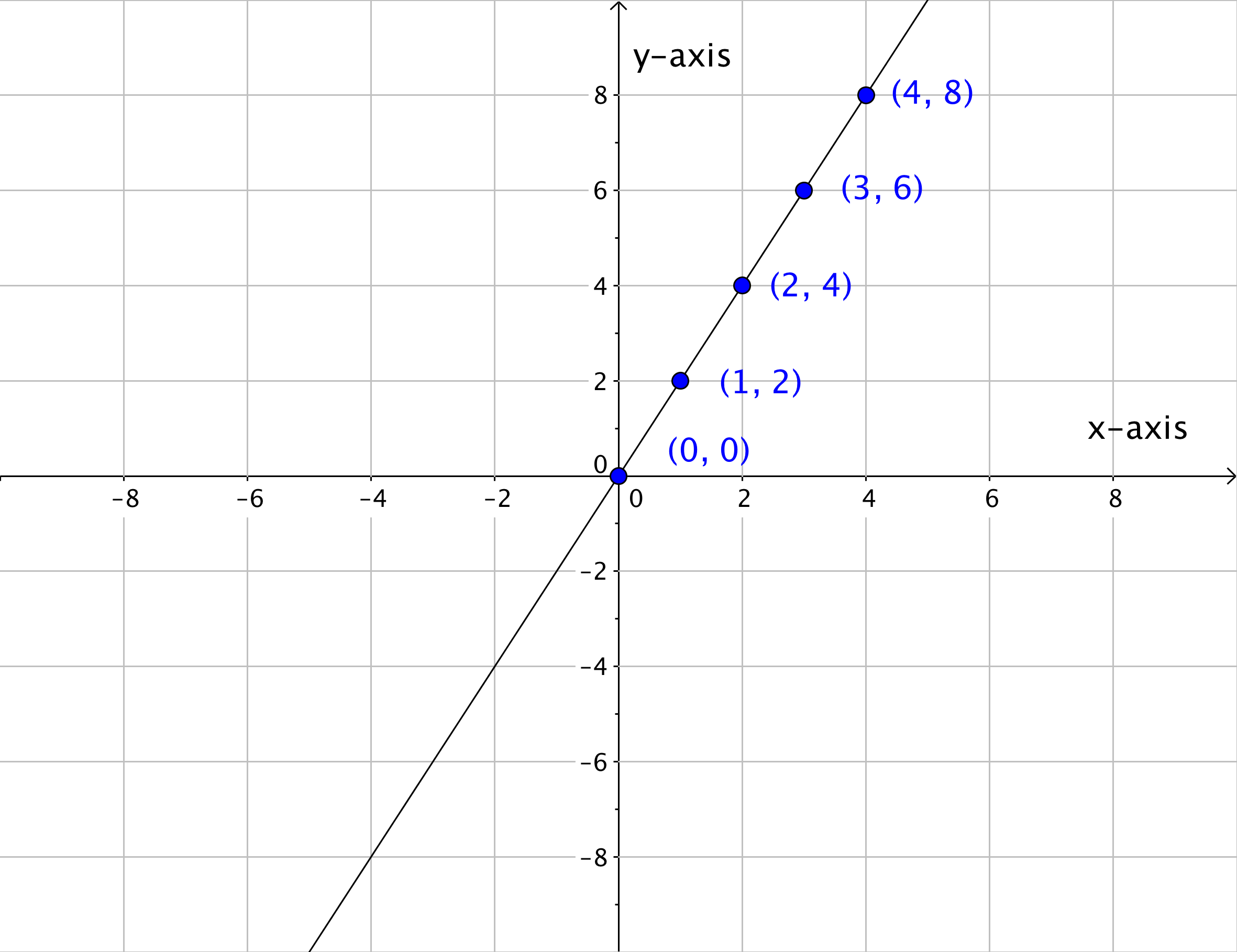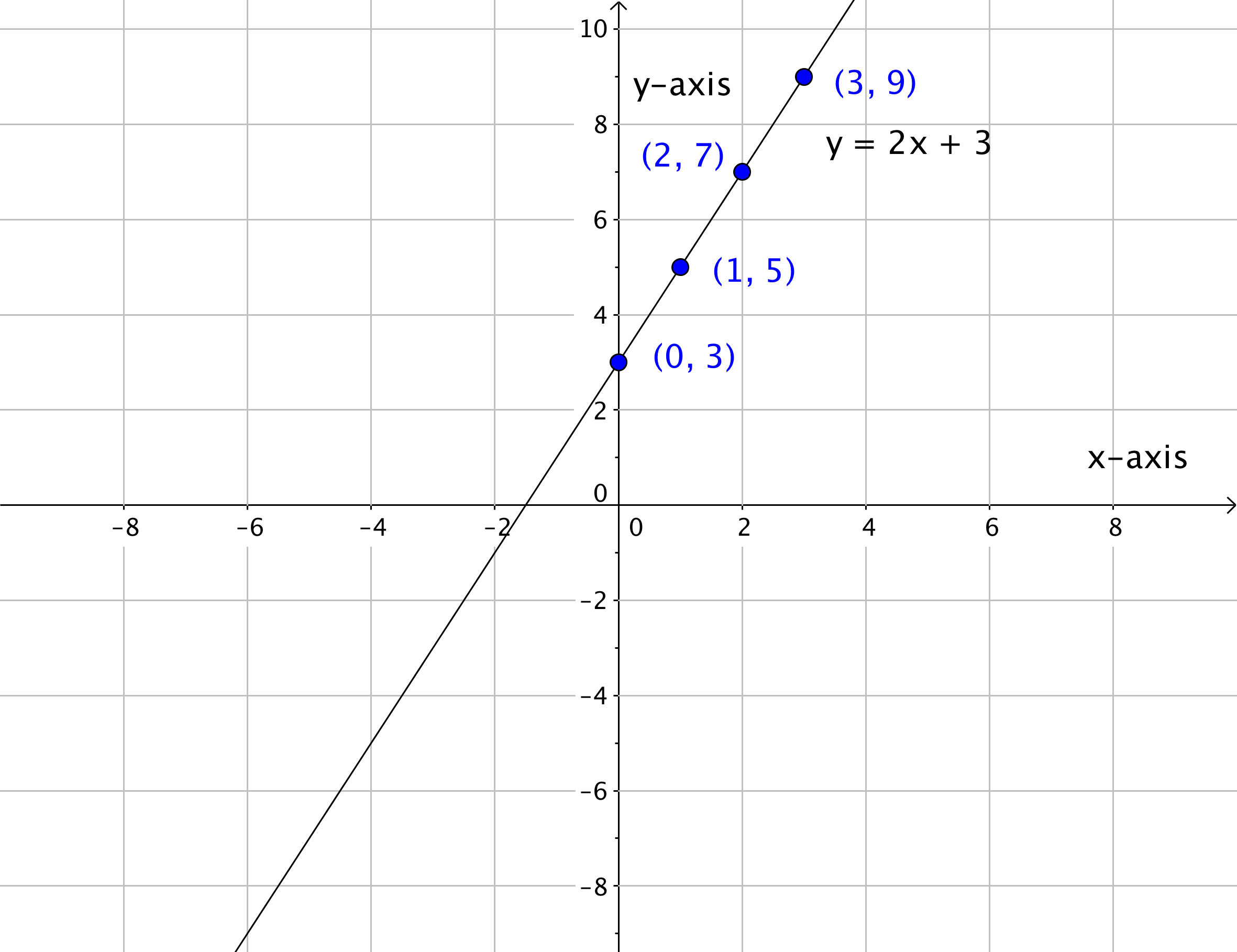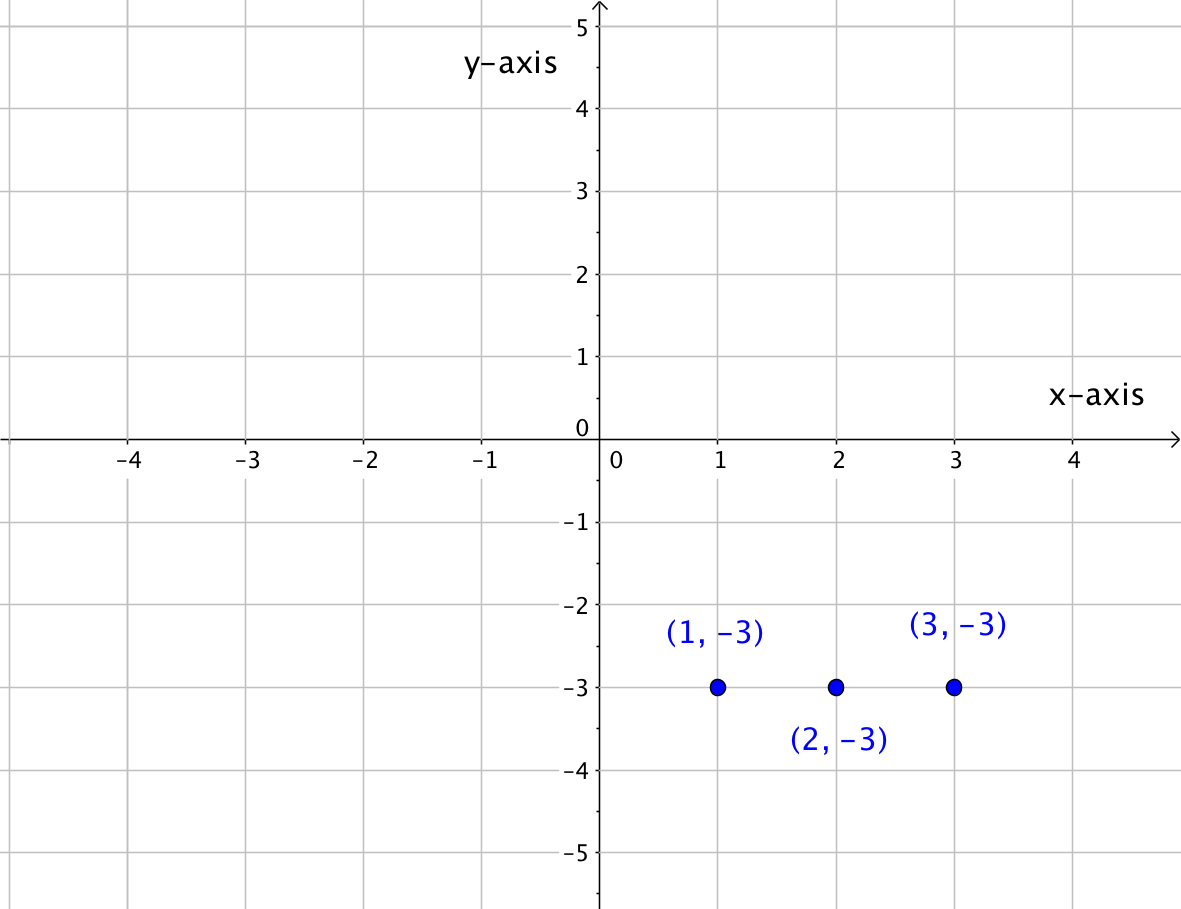section 3.3 Learning Objectives
3.3: Graphing Linear Functions
- Identify if an ordered pair is a solution to a linear equation
- Graph a linear equation by plotting points
- Identify the x-intercept and y-intercept of a linear equation
- Use the intercepts to graph a linear equation
- Graph horizontal and vertical lines
Identifying ordered pairs as solutions to linear equations
A line is a visual representation of a linear equation, and the line itself is made up of an infinite number of points (or ordered pairs). The picture below shows the line of the linear equation [latex]y=2x–5[/latex] with some of the specific points on the line.

Every point on the line is a solution to the equation [latex]y=2x–5[/latex]. You can try plugging in any of the points that are labeled, like the ordered pair, [latex](1,−3)[/latex].
[latex]\begin{array}{l}\,\,\,\,y=2x-5\\-3=2\left(1\right)-5\\-3=2-5\\-3=-3\\\text{This is true.}\end{array}[/latex]
You can also try ANY of the other points on the line. Every point on the line is a solution to the equation [latex]y=2x–5[/latex]. All this means is that determining whether an ordered pair is a solution of an equation is pretty straightforward. If the ordered pair is on the line created by the linear equation, then it is a solution to the equation. But if the ordered pair is not on the line—no matter how close it may look—then it is not a solution to the equation.
Identifying Solutions
Graphing a linear equations (using techniques learned later in this and upcoming sections) produces a line. Every point on the line is a solution to the linear equation. The line continues forever in both directions and has an infinite number of solutions.
To find out whether a specific ordered pair (x,y) is a solution of a linear equation, you can do the following:
- Substitute the x and y values into the equation. If the equation yields a true statement, then the ordered pair is a solution of the linear equation. If the ordered pair does not yield a true statement then it is not a solution.
Example 1
Determine whether [latex](−2,4)[/latex] is a solution to the equation [latex]4y+5x=3[/latex].
Graphing lines using ordered pairs
Graphing ordered pairs helps us make sense of all kinds of mathematical relationships.
You can use a coordinate plane to plot points and to map various relationships, such as the relationship between an object’s distance and the elapsed time. Many mathematical relationships are linear relationships. Let’s look at what a linear relationship is.
A linear relationship is a relationship between variables such that when plotted on a coordinate plane, the points lie on a line. Let’s start by looking at a series of points in Quadrant I on the coordinate plane.
Look at the five ordered pairs (and their x– and y-coordinates) below. Do you see any pattern to the location of the points? If this pattern continued, what other points could be included?
(0,0) , (1,2) , (2,4) , (3,6) , (4, 8) , (?, ?)
You may have identified that if this pattern continued the next ordered pair would be at (5, 10). Applying the same logic, you may identify that the ordered pairs (6, 12) and (7, 14) would also belong (if this coordinate plane were larger).
These series of points can also be represented in a table. In the table below, the x- and y-coordinates of each ordered pair on the graph is recorded.
| x-coordinate | y-coordinate |
| 0 | 0 |
| 1 | 2 |
| 2 | 4 |
| 3 | 6 |
| 4 | 8 |
Notice that each y-coordinate is twice the corresponding x-value. All of these x- and y-values follow the same pattern, and, when placed on a coordinate plane, they all line up!

Once you know the pattern that relates the x- and y-values, you can find a y-value for any x-value that lies on the line. So if the rule of this pattern is that each y-value is twice the corresponding x-value, then the ordered pairs (1.5, 3), (2.5, 5), and (3.5, 7) should all appear on the line too, correct? Look to see what happens.

If you were to keep adding ordered pairs (x, y) where the y-value was twice the x-value, you would end up with a graph like this.

Look at how all of the points blend together to create a line. You can think of a line, then, as a collection of an infinite number of individual points that share the same mathematical relationship. In this case, the relationship is that the y-value is twice the x-value.
There are multiple ways to represent a linear relationship—a table, a linear graph, and there is also a linear equation. A linear equation is an equation with two variables whose ordered pairs graph as a straight line.
There are several ways to create a graph from a linear equation. One way is to create a table of values for x and y, and then plot these ordered pairs on the coordinate plane. Two points are enough to determine a line. However, it’s always a good idea to plot more than two points to avoid possible errors.
Then you draw a line through the points to show all of the points that are on the line. The line continues endlessly in both directions. Every point on this line is a solution to the linear equation.
Example 2
Graph the linear equation [latex]y=−\frac{3}{2}x[/latex].
Example 3
Graph the linear equation [latex]y=2x+3[/latex].
Identify the intercepts of a linear equation
The intercepts of a line are the points where the line intersects, or crosses, the horizontal and vertical axes. To help you remember what “intercept” means, think about the word “intersect.” The two words sound alike and in this case mean the same thing.
The straight line on the graph below intersects the two coordinate axes. The point where the line crosses the x-axis is called the x-intercept. The y-intercept is the point where the line crosses the y-axis.

The x-intercept above is the point [latex](−2,0)[/latex]. The y-intercept above is the point (0, 2).
Notice that the y-intercept always occurs where [latex]x=0[/latex], and the x-intercept always occurs where [latex]y=0[/latex].
To find the x– and y-intercepts of a linear equation, you can substitute 0 for y and for x, respectively.
For example, the linear equation [latex]3y+2x=6[/latex] has an x intercept when [latex]y=0[/latex], so [latex]3\left(0\right)+2x=6\\[/latex].
[latex]\begin{array}{r}2x=6\\x=3\end{array}[/latex]
The x-intercept is [latex](3,0)[/latex].
Likewise the y-intercept occurs when [latex]x=0[/latex].
[latex]\begin{array}{r}3y+2\left(0\right)=6\\3y=6\\y=2\end{array}[/latex]
The y-intercept is [latex](0,2)[/latex].
Use the intercepts to graph a linear equation
You can use intercepts to graph some linear equations. Once you have found the two intercepts, draw a line through them. This method is often used when the equation is written in Standard Form.
Standard Form of a Line
One way that we can represent the equation of a line is in standard form. Standard form is given as
[latex]Ax+By=C[/latex]
where [latex]A[/latex], [latex]B[/latex], and [latex]C[/latex] are integers. The x and y terms are on one side of the equal sign, and the constant term is on the other side.
Let’s use the intercepts to graph the equation [latex]3y+2x=6[/latex]. You figured out that the intercepts of the line this equation represents are [latex](0,2)[/latex] and [latex](3,0)[/latex]. That’s all you need to know.

Example 4
Graph [latex]3x+5y=30[/latex] using the x and y-intercepts.
As we saw in the previous example, when given an equation in the form [latex]Ax+By=C[/latex], it is often easy to find the x and y-intercepts. Note that because of the communitive property of addition, [latex]Ax+By=C[/latex] is equivalent to [latex]By+Ax=C[/latex]. In the example below you will see an example where the equation is in the form [latex]By+Ax=C[/latex].
In the example below, the equation wasn’t given in the form [latex]Ax + By=C[/latex], but we can still find the x and y-intercepts in the form it is in.
Example 5
Graph [latex]y=2x-4[/latex] using the x and y-intercepts.
We mentioned that we can graph some linear equations using intercepts. So, what is the exception. In the next example, there is only one intercept; yet, we need two points to construct a graph!
Example 6
Find the [latex]x[/latex] and [latex]y[/latex]-intercepts and sketch the graph.
[latex]2x-y=0[/latex]
Solve for y, then graph a linear equation
Often times, it is easier to make a table of values if the equation is in the form [latex]y=mx+b[/latex] where m and b are real numbers. But to take advantage of this, we often must first solve for [latex]y[/latex] in the equation.
Example 7
Solve for [latex]y[/latex] and graph using a table of values.
[latex]3x+y=5[/latex].
However, we must first sometimes solve for [latex]y[/latex] ourselves to put it into this form, as demonstrated in the next example.
Example 8
Solve for [latex]y[/latex], then graph the equation using a table of values.
[latex]4x-3y=3[/latex]
The following video provides another example of solving for [latex]y[/latex] and then graphing using a table of values.
Graph horizontal and vertical lines
The linear equations [latex]x=2[/latex] and [latex]y=−3[/latex] only have one variable in each of them. However, because these are linear equations, then should graph on a coordinate plane as lines just as the linear equations above do. Just think of the equation [latex]x=2[/latex] as [latex]x=0y+2[/latex] and think of [latex]y=−3[/latex] as [latex]y=0x–3[/latex].
Example 9
Graph [latex]y=−3[/latex].
It is worth noting that there was nothing particularly special about the [latex]-3[/latex] in the above example. What you want to take from this example is that if you encounter an equation of the form [latex]y=constant[/latex], regardless of the constant, it will always result in a horizontal line.
We can take a similar approach with equations of the form [latex]x=constant[/latex].
Example 10
Graph [latex]x=2[/latex].
Once again, there was nothing special about the particular constant. We conclude that linear equations of the form [latex]x=constant[/latex] will always result in a vertical line.
HORIZONTAL AND VERTICAL LINES
- Horizontal Lines: Any linear equation of the form [latex]y=a[/latex], where [latex]a[/latex] is any real number, is a horizontal line that crosses the [latex]y[/latex]-axis at the point [latex](0,a)[/latex]
- Vertical Lines: Any linear equation of the form [latex]x=b[/latex], where [latex]b[/latex] is any real number, is a vertical line that crosses the [latex]x[/latex]-axis at the point [latex](b,0)[/latex]
In the following video you will see more examples of graphing horizontal and vertical lines.
Using function notation to express equations of lines
Because all non-vertical lines are functions, we often express the equation of a line using function notation. Recall from section 3.2, function notation can written as [latex] f(x) = [/latex]. This is read as “f of x”. It is important to note that [latex] f(x)[/latex] does not mean [latex] f [/latex] times [latex] x [/latex] but is merely a notation indicating a function using the variable [latex] x [/latex] . A function is not always indicated by [latex] f [/latex] but can be any letter, often [latex] g [/latex] or [latex] h [/latex] . In linear equations the dependent variable [latex] y [/latex] is replaced with an [latex] f(x) [/latex], as seen in the example below.
Example 11
Graph the line [latex] f(x)= \frac{1}{2}x -3 [/latex]
Summary
A solution to a linear equation is an ordered pair [latex](x,y)[/latex] that, when substituted into the equation, results in a true statement. Any linear equation in two variables has an infinite number of solutions. Graphing these solution results in a line.
We can graph lines by finding several solutions, often organized in a table of values. By convention, we typically plug in values for [latex]x[/latex], which can be made easier by first solving for [latex]y[/latex], expressing the equation in the form [latex]y=mx+b[/latex].
The intercepts of a graph are the points at which the line crosses the axes. To find the [latex]y[/latex]-intercept, plug in [latex]x=0[/latex] and to find the [latex]x[/latex]-intercept, plug in [latex]y=0[/latex]. These intercepts are often quick to determine if the equation is in the standard form, [latex]Ax+By=C[/latex]. If this results in two distinct intercepts, we can also use these to help us graph the line.
There are two special cases to watch out for, where one of the variables is missing from the equation. If an equation is of the form [latex]y=constant[/latex], it will correspond to a horizontal line. If an equation is of the form [latex]x=constant[/latex], it will correspond to a vertical line.










 Notice that [latex]y=−3[/latex] graphs as a horizontal line.
Notice that [latex]y=−3[/latex] graphs as a horizontal line.
